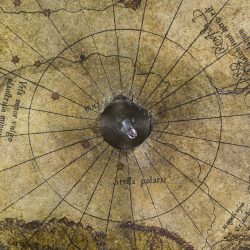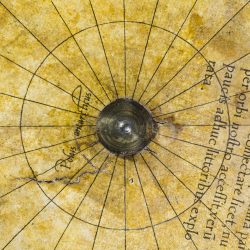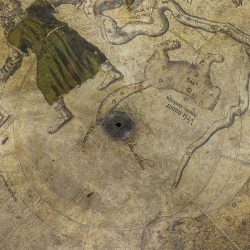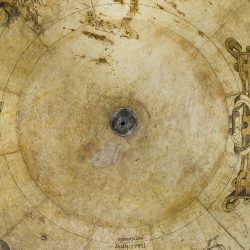Shells and layers
Each sphere is made of two hemispheres comprising multiple thin layers of alternating materials. It is difficult to determine the sequence and exact composition of the inner layers that could not be analysed but, based on binocular magnifier observations, X-rays and CT scans, they are made of cellulosic fibres in the form of cardboard or papier mâché, pieces of cloth and wood fibres (or sawdust).
While the total thickness of the spheres’ walls is difficult to determine, it is estimated to be more than 1 cm at least (as measured by a hole that does not completely cross the shell). The two cardboard half-shells were probably formed on half-balls of wood covered with soap so they could be easily detached after drying, a technique described by Denis Diderot and Jean d’Alembert in their Encyclopaedia (1751-1772). The half-shells were then pasted to form a sphere. The joint can be seen in both the CT scans and X-rays in the form of a denser white line.
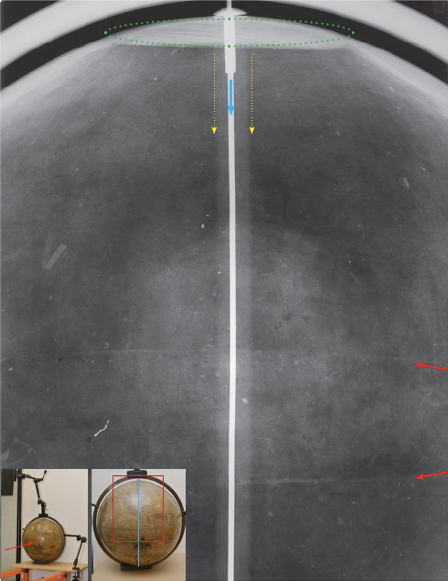
X-ray of the terrestrial globe (lower left: installation of the sphere and its position for the X-ray as seen from the machine placed one metre from the sphere. The film is just behind the sphere, pasted on the wall. The blue line indicates the position of the metal shaft and the red rectangle the area of the film). On the film we can see the northern wooden calotte (green dots) seen almost sideways, the metal shaft (blue arrow) and wooden shaft (between the dotted yellow arrows) and the joint between the two hemispheres marked by the red arrows. © SIK|ISEA
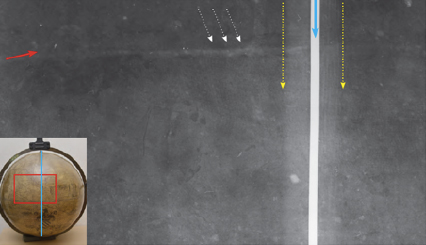
X-ray of the terrestrial globe (left-hand illustration in detail): the white dotted arrows indicate the area recognisably formed by a piece of plain-weave cloth (though this is difficult to distinguish in the image). Apparently pieces of cloth were used like papier mâché to help make the shells. © SIK|ISEA
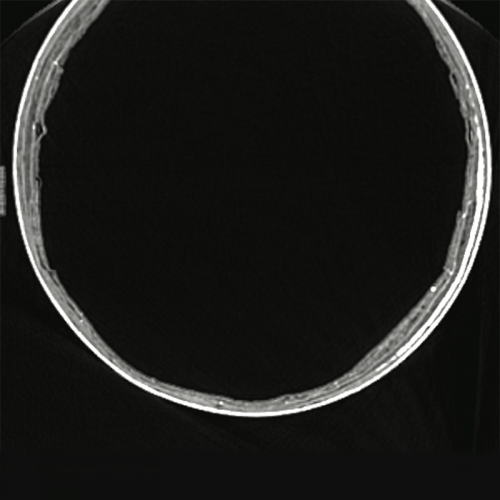
X-ray of the terrestrial globe. Cross-section of the shell, slightly towards the outer edge. The sphere is made of numerous layers which are difficult to differentiate and tend to shred in places. The chalk-paste outer layers are denser than the inner ones, which are probably made of cardboard. © SIK|ISEA
The multiple layers comprising the structure of the sphere were covered over with chalk and proteic paste, forming a smooth, homogeneous surface onto which the gores could be affixed with starch glue. There were twelve of these gores, or segments, extending to the 70th parallels, with each polar region capped by a round paper calotte.
- North Pole of the terrestrial globe
- South Pole of the terrestrial globe
- North Pole of the celestial globe
- South Pole of the celestial globe
The printed gores were coloured using paints made with various binders. For protection, the surface of the paper was then coated with varnish made from natural resins.
Find out more
- X-rays of the structure : at the Swiss Institute for Art Research, Danièle Gros further analysed the globes’ structure using X-rays, revealing a number of additional details.
- Les globes de Mercator de l’Université de Lausanne. Observations matérielles. Constat d’état. Rapport de conservation-restauration, workshop and laboratory of the Swiss Institute for Art Research SIK|ISEA, Ref. No. 141110 0002: 01/02, October 2015, Margaux Genton, Zurich.
